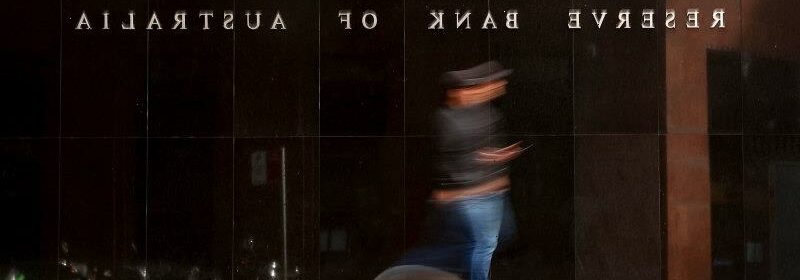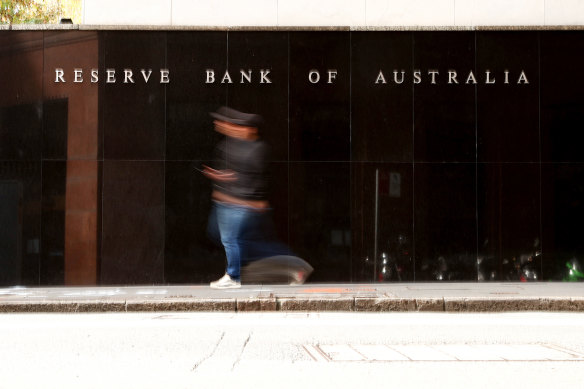Better wage growth but inflation to bite for months

Wages are forecast to grow at their fastest rate in well over a decade, but households will face higher than expected cost-of-living pressures in the coming months, sparking concerns from the Reserve Bank of a potential price-wage spiral.
Figures in the RBA’s quarterly statement on monetary policy show the bank expects wages to grow by 4.1 per cent by June and 4.2 per cent by December, according to updated forecasts, before easing to 3.8 per cent by the middle of 2025. They have not grown by 4 per cent or more since the start of 2009 and were previously forecast to reach a high of 3.9 per cent by December.
The RBA released new forecasts showing it expects higher wages growth, but sluggish economic growth over the next few years.Credit:Bloomberg
The RBA has also lifted its forecast for inflation. It is now expecting it to fall to 6.7 per cent by June, higher than the 6.3 per cent it forecast in November.
“Over the period ahead, high inflation is expected to continue to weigh on growth in real household incomes and consumption,” the report said.
“Rising interest rates are expected to add to this effect by reducing real disposable incomes for some households.”
The report noted that grocery prices, excluding fruit and vegetable, had risen 11 per cent in the past year – the biggest increase in 40 years. Discussions with businesses through its liaison program showed those prices might get higher still.
“Liaison suggests that grocery prices are likely to increase further in the near term, though at a more moderate pace than in recent quarters,” the RBA report said.
Electricity and gas prices are forecast to keep rising in the coming months, but the RBA expects wholesale costs to be dampened by the government’s price caps.
Since May last year, the Reserve Bank has lifted the official interest rate from 0.1 per cent to 3.35 per cent in its bid to tackle inflation, which reached 7.8 per cent in December.
Following Tuesday’s 0.25 percentage point increase, RBA governor Philip Lowe warned further rises were likely in the coming months. Lowe will face questions at Senate estimates and before the economics committee in Canberra next week.
The Reserve Bank wants inflation to return to its target range of 2-3 per cent and is now forecasting it will reach that range by June 2025. It wants to do so without pushing the country into a recession.
Economic growth is forecast to remain sluggish for the foreseeable future, rising to 2.3 per cent in June before falling to around 1.5 per cent and reaching 1.7 per cent by June 2025.
“The path to achieving a soft landing remains narrow,” the RBA report said. “There are considerable uncertainties surrounding the outlook and so around the level of interest rates needed to achieve the board’s objectives.”
Financial markets expect the official interest rate to be lifted to 4 per cent before the end of the year, and some economists believe there is a risk Australia will tip into a recession before the end of the year.
The bank said it was mindful that it had already made a “considerable adjustment” to rates and that it took time for rate hikes to have an effect. It said longer-term expectations for inflation and wage growth had been consistent with the bank’s inflation target, and it was vital that remained the case.
“That said, domestically sourced inflation and wages growth are both picking up. Given the importance of avoiding a price-wage spiral, the board will continue to pay close attention to both the price-setting behaviour of firms and the evolution of labour costs in the period ahead,” the report said.
Treasurer Jim Chalmers said cost-of-living pressures remained the government’s biggest focus, adding its plan to reduce energy prices was helping take the sting out of inflation in the economy.
“Our three-point plan to tackle the inflation challenge in our economy is all about providing responsible cost-of-living relief, dealing with issues in the supply chains and making sure that we’ve got the most responsible budget that we can,” he said.
“We are not surprised but we are very pleased to see that the independent Reserve Bank has said today that our energy plan will have exactly the consequences and the impact that we wanted to in taking the edge off some of this inflation in our economy.”
Shadow treasurer Angus Taylor said the government needed to address rising interest rates and cost-of-living pressures as a top priority.
“They promised before the election lower electricity prices. They promised before the election cheaper mortgages. None of this has been delivered. These numbers today confirm exactly that,” he said.
Economists said the statement on monetary policy and a shift in the RBA’s language in the statement accompanying Tuesday’s rates decision showed it was concerned inflation could stick around.
Commonwealth Bank economists expect the RBA to lift rates at its next two meetings, taking the official cash rate to 3.85 per cent by April.
“The RBA is clearly more concerned about inflation becoming entrenched,” CBA’s head of Australian economist Gareth Aird said.
“Services inflation may appear sticky over the next six months given wages growth is likely to continue to edge higher.”
David Bassanese, chief economist for Betashares, said consumer spending remained fairly resilient over the last year despite the interest rate increases, which had allowed businesses to pass supply-related costs through to buyers.
He said that resilience might also be due to the fact rising interest rates had a less direct impact on the two-thirds of households that did not have a mortgage.
“For a broader effort in slowing economic growth, more heavy lifting would need to come from fiscal policy, though so far it’s been missing in action,” he said.
Cut through the noise of federal politics with news, views and expert analysis from Jacqueline Maley. Subscribers can sign up to our weekly Inside Politics newsletter here.
Most Viewed in Politics
From our partners
Source: Read Full Article
